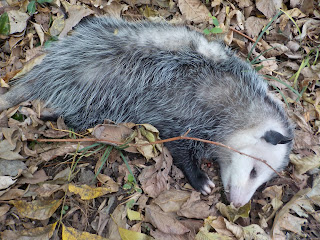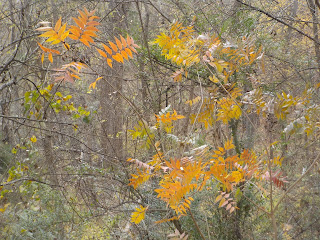Cold (17F) winter morning. Decided to go to the Woods to see if the NW Pond had frozen over; but prudently waited until the afternoon, when it was a pleasant 38F. Wandered in past the NW pond to the big down cottonwood and decided I would find a sunny, warm, south-facing tree trunk. I sat and rested against a big box elder, with the warm sun on my face. Enjoyed a half hour nap, like Rip Van Winkle. Woke up looking through the forest of green ash and wondered just how many big trees I could see. It seemed like hundreds. Fun question: how many trees in Oliver's Woods? I think I'll try to estimate. Maybe make counts at random locations along twenty 20 m x 5 m transects and extrapolate to 67 acres. I'll guess somewhere between 67,000 and 190,000.
Sitting quietly I began a 'Seton watch'. From my comfortable sunny seat I noticed strands of gossamer blowing in the wind.. and wondered if the abrupt change in the weather had produced a fluctuation in the local electric field and gotten spiders to go "ballooning" - as suggested by Morley, Gorham and Darwin.
https://www.pbs.org/newshour/science/spiders-fly-on-the-currents-of-earths-electric-field
Electric Fields Elicit Ballooning in Spiders. Erica L. Morley and Daniel Robert. Current Biology 28, 2324–2330 July 23, 2018
I set out on a slow ramble avoiding the trails. I love to get lost in the Woods and see what new things and thoughts I find. Let new questions roll into my head.
I came to an (unusual) group of four sycamores, two tall and two smaller. One of the trees looks like it could compete for the tallest tree in the Woods. I should start carrying around a forester's prism and recording the heights of the biggest trees I find. It would be interesting to know. Barring violent storm breakage, the sycamores could easily become the largest trees in the Woods. Four centuries ago this species was the largest species in the eastern US. Giant sycamores grew along the Mississippi River.
Patterns in the Woods reveal the past. I came to an old dead juniper with limbs top to bottom, a 'wolf tree' characteristic of trees growing in open fields or trees with lots of room and no over story competition. Then I saw another dead juniper much the same, and a third. They were in a line, suggesting they may have once lined the side of a road through the Woods - then perhaps an open field. It would be fun to map other limby juniper snags in the Woods and see if it was possible to reconstruct a map of where the old wagon roads may have been.
Last week I was wandering in the Woods in dry crackling leaves. Looking down at my feet, there was an accumulation of scores of small shells in a shallow depression, the size of a bathtub. Sphaeriid Fingernail clams and Physella aquatic snails (identified by mollusc experts at Oklahoma Biol Survey). No water for a quarter mile in any direction. Last winter & spring that portion of the Woods had been flooded under a couple inches of water for many months. The flood was contiguous with water from the cattails south of the NW Pond, an area that could normally sustain populations of aquatic molluscs like these two species. They would have been stranded in the small depression when the summer came and the forest dried.





